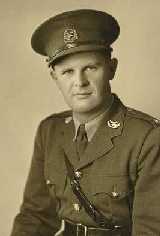 |
Crerar goes to France
Department of National Defence /
Library and Archives Canada. |
Many of us name our vehicles. They do seem to be animate enough to deserve a nickname, be it "Ol Betsy", "Rusty", or "The Green Bandit." Soldiers, too, wished to name their vehicles and for the Canadians in Italy, their right to do so became a contentious issue as the I Canadian Corps was being formed. General Harry Crerar, known for spit and polish discipline, arrived in the Italian theatre convinced that the 1st Canadian Division needed to shape up, and the painting of non-standard letters on vehicles was one aspect which needed to go.
General Chris Vokes, took a different attitude towards the naming of vehicles. As Vokes put it, "in war a soldier craves affection. He also craves something on which to lavish his affection: Jeeps, trucks, dogs, women, any damn thing he can get his hands on, even ducks and geese." (Vokes,
My Story, 153) He noted that for the truck driver, this need to show his affection to his vehicle was an extension from the days of the cavalry, when a soldier loved his horse. Vokes explained in his direct manner, "he'll paint his girl's name on the engine hood, or his wife's, or some old whore's name, it couldn't really mater. The vehicle is henceforth called by that name, and given tender loving care - proper maintenance."
Crerar finally yielded on the naming of vehicles, but insisted that names would have to be in letters no more than one inch high, inside the cab, on the dash. Reportedly, in a weeks time, acts of defiance were all too visible. Names were scrawled loud and proud, "once more sprouting from engine hoods, in the largest possible letters."
The naming of tanks had long been practiced in the Canadian Armoured Corps. Tanks usually started with the squadron letter. Tanks of "A" squadron would all begin with the letter A. An entry in the 5 Canadian Armoured Brigade diary, noted that in the multi-ethnic Eighth Army, one tank's name would have to be altered for reasons of religious sensitivity. The intelligence officer wrote, "A tk which was named ALLAH has had the name changed to ATILLA. Indian tps may have been offended at the original name."
 |
Lance-Corporal M. R. Leonard examining the "Little Henry" painting on a Sherman tank of the Three Rivers Regiment near Lucera, Italy, 21 October 1943.Credit: Lieut. Frederick G. Whitcombe / Canada. Dept. of National Defence / Library and Archives Canada / PA-201363 |


























